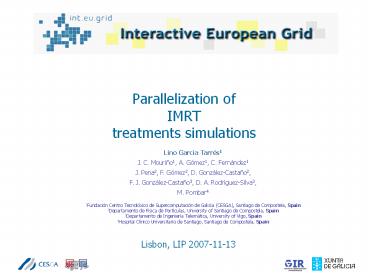Parallelization of IMRT treatments simulations - PowerPoint PPT Presentation
Title:
Parallelization of IMRT treatments simulations
Description:
2Departamento de F sica de Part culas, University of Santiago de Compostela, Spain ... 4Hospital Cl nico Universitario de Santiago, Santiago de Compostela, Spain ... – PowerPoint PPT presentation
Number of Views:42
Avg rating:3.0/5.0
Title: Parallelization of IMRT treatments simulations
1
Parallelization of IMRTtreatments simulations
Lino García Tarrés1 J. C. Mouriño1, A. Gómez1, C.
Fernández1 J. Pena2, F. Gómez2, D.
González-Castaño2, F. J. González-Castaño3, D.
A. Rodríguez-Silva3, M. Pombar4 1Fundación
Centro Tecnolóxico de Supercomputación de Galicia
(CESGA), Santiago de Compostela,
Spain2Departamento de Física de Partículas,
University of Santiago de Compostela,
Spain3Departamento de Ingeniería Telemática,
University of Vigo, Spain4Hospital Clínico
Universitario de Santiago, Santiago de
Compostela, Spain
Lisbon, LIP 2007-11-13
2
What eIMRT is ?
eIMRT means Intensity-Modulated Radiation
Therapy. Consist on a Computer-controlled x-ray
accelerator which distributes precise radiation
doses to malignant tumors.
- The radiation dose is consistent with the shape
of the tumor by - Controlling, or modulating, the radiation beams
intensity. - The profile of each radiation beam is shaped
using a multileaf collimator (MLC) and a variable
number of beams.
3
Purpose
- The application main objective is the
optimization of radiotherapy plans by computing
the amount of radiation absorbed by the human
body organs for different treatment ray
intensities, trajectories and shapes. - The inteugrid NA3 activities at CESGA is now
focused on implementing the parallelization of
the eIMRT code in order to reduce its overall
execution time. The objective is to spend less
than 60 minutes for the whole process.
4
eIMRT Architecture
5
Middleware requirements
- A typical IMRT dose analysis performs between 30
and 100 short timed jobs of about 15 minutes
each one. The main objective is to not spend more
than 60 minutes for the whole process. - Confidentiality of patient data must be
guaranteed. - Data transfer velocity a typical solution
consists of 4 trajectories (or shoots) and the
correspondent absorbed radiation file is about
1Mb in size. The whole information must be sent
in less than a second. - Disk capacity. A typical patient data topology
spends about 25Mbytes of disk storage. - The application is developed in ANSI C using XML
version 2.6 - The User interface is based on Java and MATLAB.
Final visualization tool in development. - The User interface will be web based and must
communicate with computational resources through
web services. - The application has been parallelized using
openMPI.
6
eIMRT Optimization phase
- Initialization of patient and medical equipment
simulation data. - Computation of radiation absorption by patient
body for different ray trajectories. A pool of
ray trajectories absorbed doses is finally
available. The most computationally demanding
phase. - Optimization. A pool of solutions which meets the
Doctors requirements is presented. - The Radio-Physicist selects the best solution
from the pool.
7
eIMRT verification phase
- Accelerator simulation.
- Accelerator treatment head simulation.
- Patient simulation.
- Dose delivered to the patient.
- Dose collection and end of process.
8
Parallelization strategy
- Degrees of freedom
- Radiation intensity.
- Collimator shape.
- Ray direction.
- Bed position.
Data replication Distribution of subsets of
directions among processors by using OpenMPI.
9
Preliminary Speed-Up results
- Where
- p is the number of processors.
- T1 is the execution time of the sequential
algorithm. - Tp is the execution time of the parallel
algorithm with p processors.
10
Drawbacks on initial grid tests
- Resource broker response time is slow.
- Certificate proxy timeout before job ends.
- Confidentiality of patient data, which must be
guaranteed. - The appications user interface is web based and
must communicate with computational resources
through web services.
11
Future work
- Validation porting to different MPI flavours
(PACX-MPI). - Parallelization of the Optimization phase.
- End-to-end authorization based on certificates.
- Interactivity. The user interacts with the
simulation in order to visualize the treatment
impact on the human body and to select (or
reject) the searching path to follow.
12
Interactivity demo
http//eimrt.cesga.es
Dose colorwash, isodoses and contours
Dose-Volume Histograms
Gamma and Other comparative Maps































